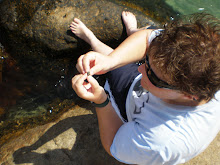I'm now a week into my EPL and its amazed me to see just how many ICTs have been integrated into the classrooms I am in. My EPL is being carried out at Sarina State High School, and while they do not have any interactive white boards they do have a wide range of ICT's that they utilise in almost every lessons. I'm taking part in a year 9 Maths class, year 10 Multistrand Science class and a year 11 Marine Aquatic Practice class.
PowerPoints and projectors are the most common thing used within the classes I have been a part of, as well as lap tops and in one class even iPods. The engagement theory is in full use with the primary ideas being real world involvement with subjects. The inclusion and ideas of the relate-create-donate framework allows for an authentic focus and project orientated learning.
Many of the classes actually use ICTs as a final product for assessment. The addition of the internet for research and collation of ideas is encouraged, and often the level of research is actually assessed. This research is then expected to be formed into a presentation. Presentations can be in any form the students feel comfortable with. Examples of these have been; websites, PowerPoint, videos, gamemaker. These are then uploaded onto the learning place for all students to have access too.
Aside from assessment, ICTs have also been integrated into the everyday running of the classroom. All notes are placed up onto the learning place for the students to access and they are encouraged to print these off to add notes to in class. This means that the students aren't preoccupied with writing down the notes verbatim and instead are allowed add to the notes where they feel they need clarification and are able to pay more attention to the teacher. They are also encouraged to take part in extension of classroom debates with the use of wikis and forums. They are often asked to participate in these wikis and then form their own arguments on issues (for example their ideas on abortion, or on the conservation of the reef). This method of helping the students form ideas and present their own opinions can be seen to be really beneficial. Many students may not feel comfortable giving their opinions out loud to a class full of their peers, but feel much more at ease having time to write out their ideas and post them in a forum type situation. This allows them to have Maslow's Hierarchy of needs to be satisfied by giving students a place where they feel safe and comfortable to present their own ideas, and thus help with self-esteem and actualization.
The inclusion of the iPods was something I found incredibly interesting. The range of different applications that are available on these devices allows for a board number of subjects which can use them. They also get the students far more interested in the more "boring" aspects of some work.
For example the iSeismo application is used within earth science to help explain not only earthquakes to the students but also graphing, data collection and axis of movement. This gives the students real world experience and knowledge as they are able to simulate movements and immediately see the graphic illustration of the data.
The use of chemical applications such as The Chemical Touch allows students to have an interactive database for chemical elements that presents students with the basics of the element (atomic number, configuration, electron negativity). This differs from a hardcopy of the periodic table as it allows the students to see the periodic table separated into groups (colour coded) based on mass, density, melting point etc. By touching a specific element students are also able to have further information on the elements properties. These applications also allow for further investigation and research by the inclusion of links through to web pages that continue to address specific information (for example the different configurations of solutions).
The use of applications helps students form links from one use of ICTs to another, as most student based applications also have the capacity for opening the relevant internet sites for further research. I believe that this allows for students to have a more learner centered approach to their education. They are given the tools that help them continue their learning as far as they wish to take it.
Of course, the use of these ICTs within the classrooms is often used as a reward for good behaviour, and there is an agreement within the school for responsible use of the technology. Websites such as facebook are not accessible and students are expected to follow the guidelines and rules for internet use. If they are unable to do this, they are excluded from engaging in the technology. This has been seen to be a useful Behaviour management tool in some classrooms.
All in all, so far I have been very impressed with the use of ICTs. The ideas that the teachers and students have come up with so far to increase the wide use of technology and the final products that have been presented have been astounding! I just hope that I can bring my own knowledge and understanding of ICT's into the classroom in a productive manner and maybe even introduce some ideas that the students haven't been exposed to yet.
Subscribe to:
Post Comments (Atom)

Hi Chloe,
ReplyDeleteYour school sounds very much the same as mine! It is great isn't it? I think that the students respond very well to it too! The Ipod implementation sounds great! I would never thought of this until reading your blog. At the school I am at, Ipods are used for playing music in dance and that is about it.
Thanks for sharing.
Courtney Rice